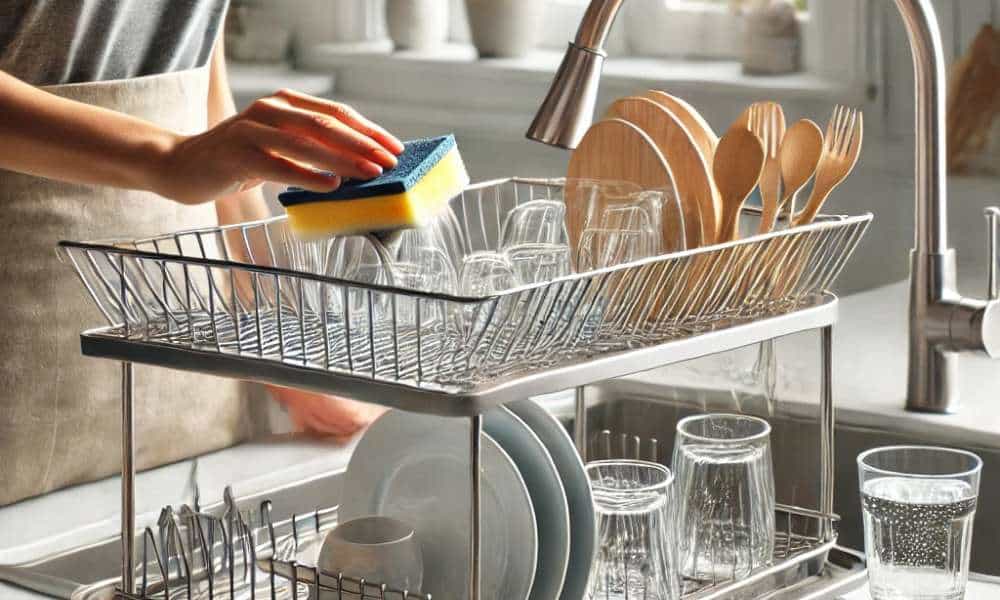A dish drying rack is a kitchen essential that helps keep your dishes organized and allows them to air dry efficiently. However, over time, it can become a breeding ground for bacteria, mold, and unpleasant odors due to constant exposure to moisture and food particles. Learning how to clean dish drying rack properly not only ensures a hygienic environment for your dishes but also extends the lifespan of the rack itself. In this guide, we’ll walk you through simple, effective steps to keep your dish drying rack spotless and germ-free, making your kitchen a healthier place.
1. Why You Should Clean Your Dish Drying Rack Regularly
Cleaning your dish drying rack regularly is paramount for several reasons. Firstly, preventing bacteria and mold growth is critical. Moist environments create the perfect conditions for harmful microbes to flourish, potentially contaminating your clean dishes. Secondly, neglect can lead to persistent, unpleasant odors that linger in your kitchen, undermining its freshness. Lastly, routine cleaning helps extend the lifespan of the rack, protecting against corrosion, rust, and material degradation. By incorporating regular maintenance into your routine, you not only safeguard your health but also preserve the rack’s functionality.
2. Identifying the Type of Dish Drying Rack You Have
Understanding the material composition of your dish drying rack influences the cleaning method:
- Stainless Steel Racks: Renowned for durability but susceptible to rust if not dried thoroughly after cleaning.
- Plastic Racks: Lightweight and affordable yet prone to mold and mildew buildup in hidden crevices.
- Bamboo/Wooden Racks: Eco-friendly with aesthetic appeal, though vulnerable to rot and warping without proper care.
Each material demands tailored maintenance to ensure longevity and cleanliness. Recognizing your rack type helps in selecting the appropriate cleaning agents and techniques.
3. Supplies You’ll Need
Before diving into the cleaning process, gather these essentials:
- Mild dish soap for gentle yet effective cleaning
- White vinegar as a natural disinfectant
- Baking soda to combat stubborn stains
- A soft brush or old toothbrush for detailed scrubbing
- Microfiber cloth for thorough drying
- Optional: Lemon juice for a refreshing, natural scent
4. Step-by-Step Guide: How to Clean Dish Drying Rack
- Disassemble the Rack (if applicable) to access hard-to-reach areas.
- Rinse Off Loose Debris under warm running water to remove surface grime.
- Soak in Warm, Soapy Water for 15-20 minutes to loosen dirt and grease.
- Scrub Away Grime using a soft brush, focusing on joints, corners, and grooves where mold thrives.
- Use Vinegar & Baking Soda for stubborn stains. Sprinkle baking soda, spray vinegar, allow fizzing, then scrub gently.
- Rinse Thoroughly to ensure no soap or cleaning residue remains.
- Dry Completely with a microfiber cloth to prevent moisture buildup, which can lead to mold and rust.
5. Dealing with Tough Issues
- How to Remove Mold from Dish Drying Rack: Mix equal parts vinegar and water, spray generously, let sit for 10 minutes, then scrub with a brush.
- How to Get Rid of Hard Water Stains: Apply lemon juice directly onto the stains, let it sit for 5-10 minutes, then scrub with a soft brush.
- Preventing Rust on Stainless Steel Racks: Regularly dry thoroughly and occasionally apply a thin layer of mineral oil to create a protective barrier against moisture.
6. How Often Should You Clean Your Dish Drying Rack?
Aim for weekly light cleaning to prevent daily grime buildup and monthly deep cleaning to tackle hidden mold, mildew, and mineral deposits. Signs that immediate cleaning is necessary include visible mold spots, unpleasant odors, or water stains.
7. Maintenance Tips to Keep Your Dish Rack Clean Longer
Keep your dish drying rack in optimal condition with a few simple habits. Always wipe it dry after each use to eliminate lingering moisture that fosters mold growth. Position the rack in a well-ventilated area to enhance airflow, reducing dampness and mildew formation. Utilizing a drip tray helps catch excess water, preventing puddles that can lead to corrosion or stains. Lastly, rotating dish placement occasionally minimizes water pooling in specific areas, ensuring even wear and easier maintenance.
8. Eco-Friendly Cleaning Methods
Opt for eco-friendly cleaning techniques to maintain both your dish rack and the environment. Lemon juice and vinegar are natural disinfectants, cutting through grime effectively without the need for harsh chemicals. For a homemade cleaning solution, mix equal parts water and vinegar with a few drops of essential oil for a fresh scent. This DIY disinfectant spray is not only effective but also safe for daily use, reducing your reliance on commercial cleaners.
9. Common Mistakes to Avoid
Avoid common pitfalls when cleaning your dish drying rack to ensure its longevity. Ignoring small mold spots can lead to rapid spreading, causing extensive damage over time. Using abrasive brushes may scratch delicate materials, especially stainless steel, compromising both appearance and durability. Additionally, not drying the rack properly after cleaning leaves residual moisture, creating the perfect environment for mold, mildew, and rust to thrive.
Conclusion
Maintaining a clean dish drying rack is vital for a healthy and hygienic kitchen environment. Regular cleaning not only prevents the buildup of mold, bacteria, and rust but also extends the lifespan of your dish rack, ensuring it remains a reliable part of your kitchen setup. By incorporating simple cleaning habits, using eco-friendly solutions, and avoiding common mistakes, you can keep your dish rack looking pristine and functioning optimally. A little effort goes a long way in preserving both your dishware and the heart of your kitchen.

